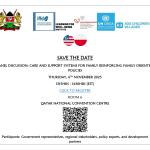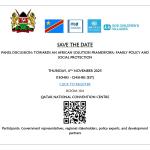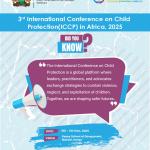Planning and Development
Functions
In fulfilment of the Secretary’s functions under the Children Act, 2022 Part IV, Sec 37,38 & 39 the department supports by performing the following functions;
- Coordinate & represent the Directorate in Finance and budgeting processes i.e. participation in budgeting& preparation of AIES
- Coordinate the overall management of Child Protection Information Management System (CPIMS)
- Compile, collate and maintain child protection data
- Coordination & facilitation of Performance Appraisal System (PAS), annual workplans, monitoring, and strategic planning.
- Communication and Public Relations.
- Coordination of the Monitoring & Evaluation (M&E) of programmes and projects.
- Coordinate research, surveys and assessments on identified gaps in child protection issues and dissemination of findings.
- Liaison with DCS stakeholders on child matters.
- Coordinate career training and development of child protection workforce and para-professionals (e.g. Child Protection Volunteers (CPVs)).
- Maintenance of departmental records on human resource & inventories on assets and liabilities
- Coordinate supervision of field offices/officers.
- Staff management and welfare (in liaison with SDSP HRM&D)
- Coordinate the development and consolidation of Annual Work Plans, Performance appraisal, MTP and MTEF.
- Coordinate the development of Memorandums of Understanding (MoUs) with partnering organizations.
- Coordinate dissemination of laws, policies, and guidelines on child protection.
- Initiate and coordinate programmes to respond to emerging issues from time to time.
- Publication a departmental newsletter.
1. Child Protection Information Management System (CPIMS)
- CPIMS is a web-based government system for collection and management of child protection data.
- CPIMS comprises of 5 modules namely; Registry, Forms, Reports, GIS and gallery Modules.
- New modules to improve on data collection namely; alternative family care, statutory children institutions and OVC modules
- CPIMS currently has a total of 2,778,168 children, 9,578 Workforce members and 2,166 organisation units (NB- since its inception in 2016).
Objectives;
- To ease data capture, storage and retrieval.
- To enhance the quality of child protection data collected and reported,
- To enrich case management of child protection cases.
- To enhance tracking of children for ease of service delivery
CPIMS Benefits
- Improved data quality, evidence-based decision making.
- It acts as a repository of CP data (stores and allow quick access)
- Improved data reporting and sharing to state and non-state agencies.
- It also increases visibility of CP in the County through publication.
- Strengthened coordination, partnership and supervision of CP programmes and services
CPIMS - achievements
- Upgrading and roll-out of CPIMS to all the 47 Counties and 364 sub counties;
- Linking of the Child Help Line 116 to the CPIMS;
- Development, updating & upgrading of DCS online public data portal, http://data.childprotection.go.ke/
- Development & updating of Learning site: learning.childprotection.go.ke/
- Preparation of DCS Child protection Annual reports
- Coordination of virtual child protection trainings on new CPIMS modules
- Development and rolling out of offline data mode –Vurugu mapper
- Coordination with KNBS for Publishing of Child protection Data in KNBS annual report (has been carried out in the last 4years – 2022-2024)
2. Strengthening of Child Protection Service Workforce
This programme is aimed at equipping frontline child protection workers with the skills and knowledge to fulfill their mandate. It entails a 10-days and a 5-days competency-based training package covering critical aspects of child protection work.
Achievements;
- Training and capacity building of child protection workforce and para-professionals (e.g. children officers & Child Protection Volunteers (CPVs).
- 45 master trainers/TOTs who deliver the training as KSG adjunct lecturers
- 438 child protection practitioners in seven (7) cohorts with 274 from Government and 164 from civil society organizations
- 1041 para-professional child protection volunteers and other lower – level cadres in 20 counties trained
- Implementation of Child Protection Social Service Workforce curriculum hosted at Kenya School of Government (KSG).
- Review and alignment of the child protection workforce and para-professionals training manuals with the Children Act 2022
- Successful dissemination of assessment report for social service workforce and Investment case to State Department HODs and relevant stakeholders
3. Research: International Conference on child Protection (ICCP) in Africa
- The International Conference on Child Protection Africa is a biennial event organized by the Government of Kenya through the Ministry of Labour and Social Protection.
- It is jointly organized by both state and non-state actors with the lead agency being the State Department
- The conference focuses on emerging child protection issues which is a menace at both regional and global level.
- Participants share and interrogate existing evidence and chart pathways to ending challenges facing children in the interest of creating safer environments.



